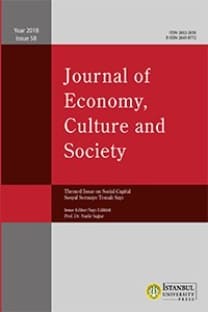En İyiyi Ümit Edip En Kötüye Hazırlıklı Olmak: Türkiye’de Müzisyenlik Mesleği Üzerine Sosyolojik Bir Araştırma
Bu çalışma, Türkiye’de müzisyenlik mesleğini, sosyo-ekonomik statü, davranışsal örüntüler ve kültürel bileşenler açısından incelemeyi amaçlamaktadır. Bu çerçevede, ülkemizde müzisyenlik mesleğinin farklı boyutlarının nasıl yapılandırıldığı, ifade edildiği ve algılandığını ortaya çıkarmak çalışmanın ana hedefidir. Çalışmanın temel araştırma metodu, ciddi müzik ve popüler müzik alanları altında toplanan farklı müzik türlerinde çalışmalar ortaya koyan eğitimli ve profesyonel 12 müzisyen ile gerçekleştirilen yarı-yapılandırılmış derinlemesine görüşmeleri içermektedir. Araştırma sonucunda, birer sanatçı olarak müzisyenlerin kendi mesleklerinin itibarı ve saygınlık düzeyi konusunda tereddütlerinin bulunduğunu ortaya çıkmıştır. Ciddi müzik türlerine yönelik ilginin azalıp tüketime hazır son moda müzik türlerine ilginin artması, yeni medya teknolojilerinin müzik alanına müdahil olması, profesyonel iş ağının içinde kalıp müzik piyasasının taleplerine uymaya gayret ederken, bir yandan da yaratıcı ve özgün işler yapmaya çalışmak, müzisyenlerin günümüzde karşılaştığı temel güçlükler arasında ifade edilmiştir. İş güvencesi ve düzenli gelir konusundaki sorunlar da bu listeye eklenerek, serbest-çalışmanın müzisyenlik mesleğinin kaçınılmaz bir boyutu olduğu dile getirilmiştir. Öte yandan, menajerlik alanındaki iyileşmeler ve gelişmekte olan yenilikçi performans fikirleri, ümit vadeden gelişmeler arasında sayılmıştır. Ayrıca, müzisyenler diğer meslek gruplarıyla pek çok ortak mesleki davranışsal özellikler paylaşsalar da, sabırlı, disiplinli, iş birliğine yatkın ve çalışkan olmak, kariyer başarısı açısından gerekli nitelikler arasında belirtilmiştir.
Anahtar Kelimeler:
Müzisyenlik, müzik piyasası, mesleki davranışsal özellikler
Hoping for the Best, Preparing for the Worst: A Sociological Study on Being a Musician in Turkey
This study aims to analyze the socio-economic status, behavioral patterns and cultural constituents of being a musician in Turkey. The main objective is thus to unveil various different aspects of how musicianship is structured, expressed and perceived in Turkey. This research employs semi-structured in-depth interviews with 12 educated and professional Turkish musicians of different genres, which are grouped under the categories of serious and popular music. The main findings put forth that musicians, as artists, seem a bit unsure about the occupational prestige of their job. Lack of interest in serious music, inclination towards more trendy and ready-to-consume genres, interventions of new media technologies, trying to maintain a professional artistic network and to meet the demands of the music market while trying to stay creative and authentic, together with job insecurity and income instability are reported among the major difficulties that musicians face today. Engaging in free-lance work is also deemed an inevitable dimension of their job. Improvements in the management of musicians and the flourishing of innovative performance ideas came to the forefront as promising developments. Moreover, even though musicians share many behavioral patterns with other professionals, being patient, disciplinary, cooperative and hard-working, were listed among the necessities for musicians’ career success.
___
- Adorno, T.W. (1994). Introduction à la sociologie de la musique. Geneve: Contrechamps.
- Adorno, T.W., & Horkheimer, M. (1991). The culture industry. London: Routledge.
- Attali, J. (1989). Noise. Manchester: Manchester University Press.
- Becker, H. (1997). Art worlds. Berkeley: University of California Press.
- Bourdieu, P. (1984). Distinction: A social critique of the judgment of taste. Cambridge: Harvard University Press.
- Bourdieu, P. (1990). The logic of practice. Cambridge: Stanford University Press.
- Bernard, H.R. (2006). Research methods in anthropology: Qualitative and quantitative methods. Oxford: Altamira Press.
- Cahn, W. L. (1992). Authority and motivation in the symphony orchestra: a symphony musician’s point of view. Contemporary Music Review, 7(1), 27—38.
- Chanan, M. (1994). Musica Practica. The social practice of Western music from Gregorian chant to postmodernism. London: Verso.
- Dyce, J. A., & O’Connor, B. P. (1994). The personalities of popular musicians. Psychology of Music, 22(2), 168— 173.
- Frederickson J. and Rooney, J. F. (2016). The free-lance musician as a type of non-person: An extension of the concept of non-personhood. The Sociology Quarterly, 29(29), 221—239.
- Imik, Ü., & Haşhaş, S. (2016). Türkiye’de müzisyen olmak. Istanbul: Gece Kitaplığı.
- Nash, D. J. (1957). The socialization of an artist, the American composer. Social Forces, 35(307), 3—13.
- Pedler, E. (2010). Les sociologies de la musique de Max Weber et Georg Simmel : Une théorie relationnelle des pratiques musiciennes. L’Année sociologique, 60(2), 305—330.
- Perrenoud M., & Bataille, P. (2017). Artist, craftsman, teacher: “Being a musician” in France and Switzerland. Popular Music and Society, 40(5), 592—604.
- Publicover, J.L., Wright, T.S., Baur, S., & Duinker, P.N. (2019). Engaging with Environmental Issues as a Musician: Career Perspectives from the Musicians of the Playlist for the Planet. Popular Music and Society, 42(2), 167— 187.
- Stokes, M. (2002). Marx, money and musicians. Music and Marx. Ideas, practice, politics. Regula B. Quresh (Ed.). London: Routledge.
- Sutopo, O. R., Nilan, P., & Threadgold, S. (2017). Keep the hope alive: young Indonesian musicians’ views of the future. Journal of Youth Studies, 20(5), 549—564.
- Tagg, P. (1982). Analyzing popular music: Theory, method and practice. Popular Music, 2, 37—67.
- Vaag, J., Giæver, F., & Bjerkeset, O. (2014). Specific demands and resources in the career of the Norwegian freelance musician. Arts & Health, 6(3), 205—222.
- Wiggins, J. (2011). Vulnerability and agency in being and becoming a musician. Music Education Research, 13(4), 355—367.
- Williams, R. (2005). Anahtar sözcükler: Kültür ve toplumun söz varlığı (S. Kılıç, Trans.) İstanbul: İletişim Yayınları. Woody II, R. H. (1999). The musician’s personality. Creativity Research Journal, 12(4), 241—250.
- ISSN: 2602-2656
- Yayın Aralığı: Yılda 2 Sayı
- Başlangıç: 1960
- Yayıncı: İstanbul Üniversitesi Yayınevi
Sayıdaki Diğer Makaleler
Mesleğin Hayatı Belirleme Pratikleri: Bankacı ve Tır Şoförü Örneği
Standart Sınavlar ve Dönüşen Öğretmen Kimliği
Yunus Emre ÖMÜR, Bünyamin BAVLI
Sosyo-Ekonomik Değişmeyle Başa Çıkmak: Küçük Esnafın Taktikleri
Türkiye’de Toplumsal Tabakalaşma ve Hareketliliğin Meslekler Üzerinden Ölçümü
Yaşanmış Deneyimler ve Öznellikler Çerçevesinde Tabakalaşmayı Okumak
Kadın Akademisyenlerin Kariyer Kimliği İnşası: Araştırma Yapmak İsteyen Anne Öğretim Üyesi
H. Merve BİRCAN, Nihat ERDOĞMUŞ
Türkiye’de Mesleki İtibar: Dönüşen Çalışma Hayatı ve Mesleklerin Sosyal Konumu
Çevrimiçi Dönüşümün Mesleki Tezahürü: E-Spor Faaliyetleriyle “Dijital Oyuncular Kuşağı”
Burcu KAYA ERDEM, Rukiye CİVAN KEMİKSİZ
